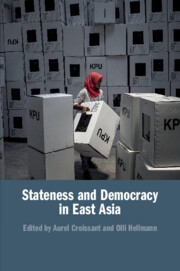Book contents
- Stateness and Democracy in East Asia
- Stateness and Democracy in East Asia
- Copyright page
- Contents
- Figures
- Tables
- Contributors
- Acknowledgements
- 1 Introduction: Rethinking Stateness and Democracy in East Asia
- 2 State-Building and Democratization
- 3 South Korea’s Democracy and the Legacies of the Developmental State
- 4 After Hegemony: State Capacity, the Quality of Democracy and the Legacies of the Party-State in Democratic Taiwan
- 5 Democratization Interrupted: The Parallel State and the Demise of Democracy in Thailand
- 6 Weak State and the Limits of Democratization in Cambodia, 1993–2017
- 7 The Institutional Roots of Defective Democracy in the Philippines
- 8 Stateness and State Capacity in Post-Authoritarian Indonesia: Securing Democracy’s Survival, Entrenching Its Low Quality
- 9 As Good as It Gets? Stateness and Democracy in East Timor
- 10 Stateness and Democracy: Evidence from East Asia and Cross-Regional Comparisons
- Index
- References
7 - The Institutional Roots of Defective Democracy in the Philippines
Published online by Cambridge University Press: 13 May 2020
- Stateness and Democracy in East Asia
- Stateness and Democracy in East Asia
- Copyright page
- Contents
- Figures
- Tables
- Contributors
- Acknowledgements
- 1 Introduction: Rethinking Stateness and Democracy in East Asia
- 2 State-Building and Democratization
- 3 South Korea’s Democracy and the Legacies of the Developmental State
- 4 After Hegemony: State Capacity, the Quality of Democracy and the Legacies of the Party-State in Democratic Taiwan
- 5 Democratization Interrupted: The Parallel State and the Demise of Democracy in Thailand
- 6 Weak State and the Limits of Democratization in Cambodia, 1993–2017
- 7 The Institutional Roots of Defective Democracy in the Philippines
- 8 Stateness and State Capacity in Post-Authoritarian Indonesia: Securing Democracy’s Survival, Entrenching Its Low Quality
- 9 As Good as It Gets? Stateness and Democracy in East Timor
- 10 Stateness and Democracy: Evidence from East Asia and Cross-Regional Comparisons
- Index
- References
Summary
The Philippines stands out as the first and longest democracy in Southeast Asia. However, except for elections, democracy in the Philippines is a low quality or ‘defective democracy’. In this chapter, we first empirically document the low quality of Philippine democracy. We then advance an argument that explains the pathological condition of Philippine democracy in terms of the fecklessness of its core institutional structures. This institutional weakness can be explained by two significant historical-structural factors: the sequencing of the advent of electoral democracy vis-a-vis the building of the state and the absence of social cleavages in the Philippines. The advent of electoral democracy in the Philippines prior to any effort to build a functioning, autonomous and rationalized bureaucratic state has effectively created favorable conditions for traditional oligarchs to dominate state structures since the American colonial days. The fact that social cleavages never became articulated into the party system has further led to the creation of political parties as clientelistic shells, devoid of any substantive, programmatic agenda that would serve the public good.
- Type
- Chapter
- Information
- Stateness and Democracy in East Asia , pp. 153 - 178Publisher: Cambridge University PressPrint publication year: 2020
References
- 2
- Cited by

